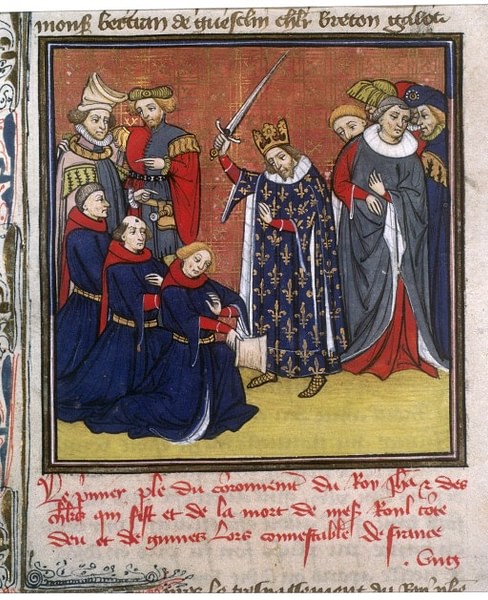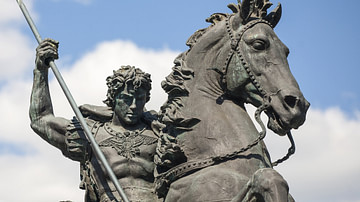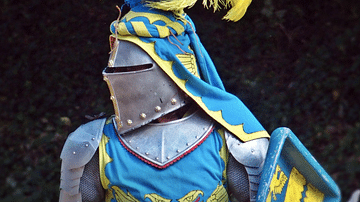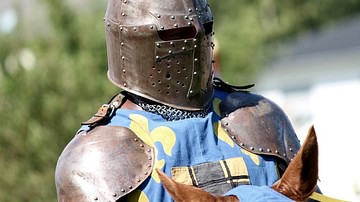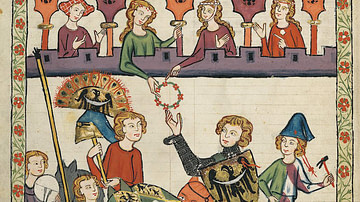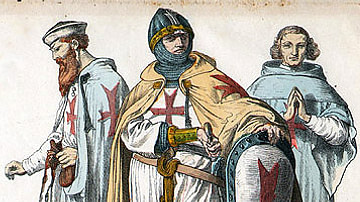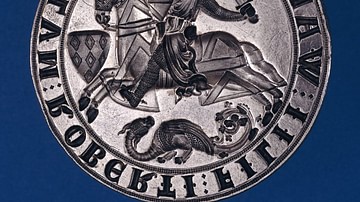In medieval society a knight enjoyed a position of high status and often wealth, they were feared on the battlefield and known for their chivalry off it, but it took a long time and a lot of training to get there. Trained in weapons handling and horse-riding from childhood, a young man could be made a knight by the local lord he served, through exceptional bravery on the battlefield, and, at least in later times when European monarchs desperately needed funds and men of skill for their armies, the position could even be bought. In any case, a knight underwent an elaborate initiation ceremony, after which they were expected to uphold the chivalric traditions of their rank and courageously face the best-equipped and most heavily armed opponents in battle, the knights of the enemy's army.
Although there was no fixed system, age ranges varied, and some youths never qualified for the next stage, the general steps to become a medieval knight were as follows:
- Page - from age 7-10 to 13, become familiar with horses, hunting and the use of mock weapons by serving a local knight, baron, or royal court.
- Squire - from age 14 to 18-21, assist a full-knight, learn to use the weapons and armour of war, and improve one's general education, especially the code of chivalry.
- Dubbing - When aged 18-21, the ceremony of being made a knight performed by another knight.
- Service - Act as a guard for a baron and his castle, fight in wars for one's sovereign and the Church, and perform in medieval tournaments.
Training 1 - Being a Page
Most knights were probably sons of knights, but there are records of the sons of a burgess or freeman being put forward for the necessary training, as well as wealthy merchants and government officials as those classes grew in the later Middle Ages. An ordinary soldier might also be made a knight for courage on the battlefield. As warfare grew ever bigger in scale and barons increasingly preferred to send knights to do service in their place, the social background of a knight became less important during wars when a sovereign needed all the armed men they could get. Generally, though, by the 13th century CE, the idea of noble lineage and preserving knighthood as a mark of a class with restricted access had taken hold across Europe. There were exceptions, notably in France and Germany and on a case by case basis, but in the main, only the son of a knight could become one.
A knight had to be accomplished in riding a horse while carrying a shield and lance, so he needed to practise guiding his steed using only the knees and feet. He must be capable of using a long and heavy sword for a sustained period of fighting and fit enough to move around with speed while wearing heavy metal armour. A proficiency with additional weapons such as a dagger, battleaxe, mace, bow, and crossbow might come in handy, too. Accordingly, a young boy earmarked by his parents or sponsor to one day become a knight had to start training young, typically as a page from the age of 10 (or even 7 in some cases), with mock weapons and basic riding skills. A young noble was likely sent to the royal court for such training while a youth from a more modest aristocratic family would be enrolled at the local castle or that of a relative to train with the knights and men-at-arms stationed there. There they would, along with other pages, serve at table, act as stable hands, perform menial tasks, and begin the education that was to continue in earnest as a teenager.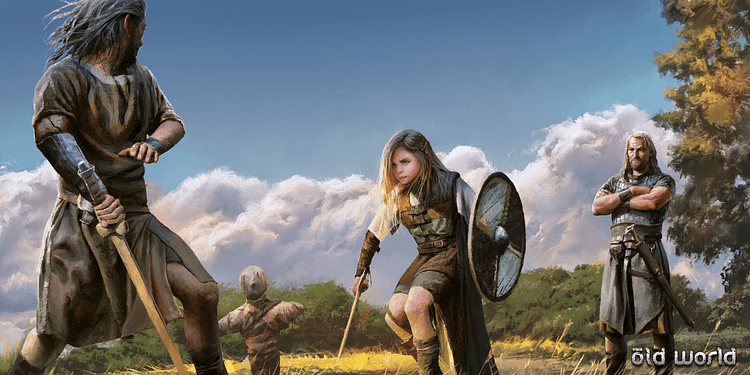
Training 2 - Being a Squire
The next step in the long road to knighthood was to become a squire (or esquire), that is a trainee knight, typically from the age of 14. The name squire derives from the French ecuyer, meaning shield bearer. Besides learning weaponry and horsemanship, the squire was expected to look after a full knight (who might have two or more squires under him), cleaning his weapons, polishing the armour, looking after the horses, helping him dress for battle, holding his shield until required, and other such general duties.
There were also non-martial but still important accomplishments to acquire such as a knowledge of music, dance, as well as reading and writing in Latin and French. They learnt to recite poetry and cultivated good manners, especially in front of aristocratic ladies with whom they went hunting and played games like chess. The literary subjects would have been taught by the local priest, perhaps too with some involvement from the lady of the castle in which they were an apprentice. Hunting wild animals and falconry were other skills on the squire's curriculum and provided useful meat dishes for the knight's table, which the squire was expected to serve at. Squires also had to train and look after the pages, including dishing out discipline, a duty they no doubt relished.
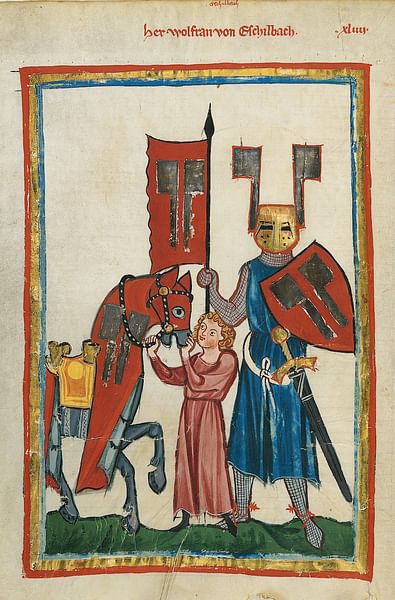
A squire's training involved practice with the lance and sword; sometimes weapons were made deliberately heavier than those used in battle to beef up muscles and make real fighting seem a little easier than it really was. The staff, bow, and crossbow were all used, too, although these were not generally used by knights in warfare. There were specific devices for training such as the quintain - a rotating arm with a shield at one end and a weight at the other. A rider had to hit the shield and keep riding on to avoid being hit in the back by the weight as it swung around. Another device was a suspended ring which had to be removed using the tip of the lance. Riding a horse at full gallop and cutting at a pell or wooden post with one's sword was another common training technique.
In actual warfare, a squire followed his knight. When on the move, the squires usually rode ahead with the extra horses and baggage. In the battle itself, after passing the knight his lance and shield, the squire followed him on another horse in case the knight's mount became incapacitated. If the knight were seriously wounded, it was the squire who was responsible for extracting him from the battlefield.
When finally fully trained, a squire could be made a knight by their lord or another knight, usually when between the ages of 18 and 21. It is not clear what happened to squires who failed in their training, although a career in the church or law might have been a common alternative for some noble children. One celebrated figure who never made the step up from squire to knight was Geoffrey Chaucer (c. 1343 - 1400 CE), author of The Canterbury Tales. Still other squires simply continued to be squires into adulthood and served a knight throughout their career. A lack of financial means might be another reason never to achieve knighthood as the cost of horses, armour, and equipment was high. Those squires who were knight material and had the means to progress underwent an elaborate initiation ceremony to welcome them into the brotherhood of knights. There were some knightings made just prior to a battle, so in that case, the ceremony had to come later but it was certainly worth the wait.
A Knighting Ceremony
The preparation for a knighting (or dubbing as it is sometimes called), which might include any number of knights-to-be, began the day before, with the squire brushing himself up with a bath and a shave or beard trim. Overnight he might spend the hours in a vigil within a chapel with his sword resting upon the altar, no doubt contemplating his good fortune on achieving his goal and pondering the risks to life and limb yet to be faced.

On the day of the ceremony the squire was dressed by two knights with a white tunic and white belt to symbolise purity, black or brown stockings to represent the earth to which he will one day return, and a scarlet cloak for the blood he is now ready to spill for his baron, sovereign, and church. The actual ceremony, which varied over time and place, might occur in the open air, in a chapel or, for the lucky ones, within the royal palace when the dubbings were usually held as part of a wider celebration such as royal weddings and coronations. The squire was fitted with gilded spurs (hence the expression 'to win one's spurs') and given back his sword, which had been blessed by a priest with the proviso he always protect the poor and weak. The blade had two cutting edges - one to represent justice, the other loyalty (or more generally, chivalry).
Then, before witnesses, the squire kneeled before the knight or king giving the honour. The person doing the dubbing was actually taking a risk with his own reputation as any glory or dishonour the new knight acquired also reflected on he who had knighted him. The 'dubber' might attach a spur or put a sword and belt on the squire, and give him a kiss on the cheek. The squire was actually knighted by a simple tap on the shoulders or neck with the hand or sword, or even a heavy blow (colée or 'accolade') - meant to be the last one he should ever take without retaliating and to remind him of his obligations and moral duty not to disgrace the man who dealt the blow. A few words might be said but nothing too fancy, perhaps a simple 'Be thou a knight'. The new knight might swear an oath of homage; this allegiance might be given to a local baron and was especially performed by tenant knights - those who held lands which were part of their baron's overall estate. Now a knight, he was given his horse, which was paid for by either his father of the person knighting him, and then his shield and banner, which might bear his family coat of arms. For a squire from a wealthy family, the occasion of his knighthood might warrant a large feast - where he could sit at the table with the other knights for the first time instead of just being the waiter - and even a tournament.
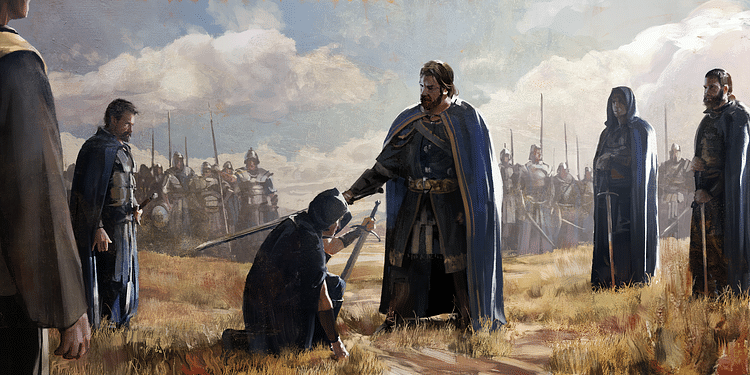
Knights in Warfare
After all this preparation and ceremony a knight was ready to fulfil his purpose: win victory on the battlefield. Knights were involved in warfare for several reasons: they were in the paid service of a local baron as part of his permanent force of household knights, they were sent to perform a duty for their sovereign by their baron or they had no particular attachment to anyone but earned their living as a mercenary. Knights might also fight for a religious cause such as during the Crusades or belong to an order of knights like the Knights Templar.
Knights were generally paid for their services, but not always if it were in service to the king in a war against another country or rebellious barons. There were advantages to national warfare as the king might then award lands and titles afterwards, and there was always the honour of not fighting for one's king for mere money.
In medieval warfare, sieges of fortified cities and castles were more common than field battles, but a knight was still expected to play their part. Knights might form raiding parties from a besieged castle, for example, and these had to be met. In battle, knights formed the front line of an army and rode in close formation, using their lance first until it was broken. Next, they wielded swords and dismounted if their horse were injured, as frequently happened. During a siege, a knight might be expected to man a siege tower or be ready to enter a fortification once it had been breached. When not fighting for real, knights were expected to keep their skills sharp by performing at tournaments where they participated in mock cavalry battles, jousted on horseback, and fought on foot in one-on-one fights.
